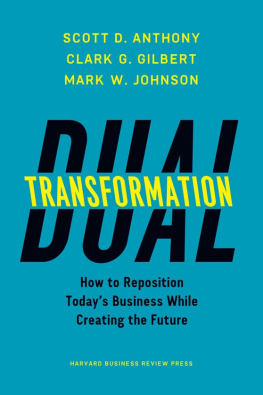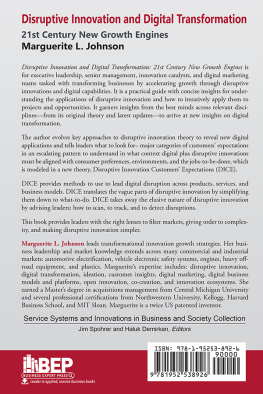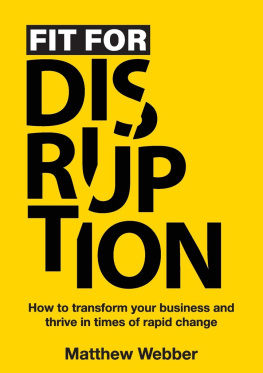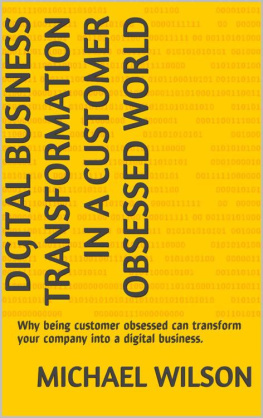Dual Transformation
Dual Transformation
How to Reposition Todays Business
and Create the Future
Scott D. Anthony, Clark G. Gilbert,
and Mark W. Johnson
Harvard Business Review Press
Boston, Massachusetts
HBR Press Quantity Sales Discounts
Harvard Business Review Press titles are available at significant quantity discounts when purchased in bulk for client gifts, sales promotions, and premiums. Special editions, including books with corporate logos, customized covers, and letters from the company or CEO printed in the front matter, as well as excerpts of existing books, can also be created in large quantities for special needs.
For details and discount information for both print and
ebook formats, contact booksales@harvardbusiness.org,
tel. 800-988-0886, or www.hbr.org/bulksales.
Copyright 2017 Scott D. Anthony, Clark G. Gilbert, and Mark W. Johnson
All rights reserved
Printed in the United States of America
10987654321
No part of this publication may be reproduced, stored in or introduced into a retrieval system, or transmitted, in any form, or by any means (electronic, mechanical, photocopying, recording, or otherwise), without the prior permission of the publisher. Requests for permission should be directed to permissions@hbsp.harvard.edu, or mailed to Permissions, Harvard Business School Publishing, 60 Harvard Way, Boston, Massachusetts 02163.
The web addresses referenced in this book were live and correct at the time of the books publication but may be subject to change.
Library of Congress Cataloging-in-Publication Data
Names: Anthony, Scott D., author. | Gilbert, Clark G., author.
| Johnson, Mark W., author.
Title: Dual transformation : how to reposition todays business and create the
future / Scott D. Anthony, Clark G. Gilbert, and Mark W. Johnson.
Description: Boston, Massachusetts : Harvard Business Review Press, [2017]
Identifiers: LCCN 2016043734 | ISBN 9781633692480 (hbk)
Subjects: LCSH: Reengineering (Management) | Organizational resilience.
| Organizational effectiveness. | Strategic planning.
Classification: LCC HD58.87 .A58 2017 | DDC 658.4/06dc23 LC record available
at https://lccn.loc.gov/2016043734
The paper used in this publication meets the requirements of the American National Standard for Permanence of Paper for Publications and Documents in Libraries and Archives Z39.48-1992.
Contents
1. Disruptive Shock Waves and
Dual Transformation
The year is 1975.
The Boston Red Sox lose in the World Series in heartbreaking fashion, again. The disco era begins, with the Bee Gees Jive Talkin and Earth, Wind & Fires Shining Star topping global charts. In the town of Rochester, New York, a young engineer named Steve Sasson creates a disruptive technology that allows a consumer to capture what we now call a digital image. The device is as big as a toaster and takes more than twenty seconds to capture an image, but the seeds of disruption are sown. Far from working for an upstart company, Sasson works for Eastman Kodak. At the time the company dominates the silver halide chemical film market, with an 80 percent share and a 70 percent gross profit margin. And now it has a prototype for a camera that uses no film.
What happens next?
You probably know the story. Kodak invests heavily in the new technology, introducing its first digital camera in 1990. By 2000 it emerges as one of the leading digital imaging producers. In 2001 it makes the bold move to purchase an emerging photo sharing site called Ofoto. Embracing its historical tag line, Share memories, share life, Kodak rebrands Ofoto as Kodak Moments, transforming it into the leader of a new category called social networking, where people share pictures, personal updates, and links to news and information. In 2010, it attracts a young engineer from Google named Kevin Systrom, who takes the site to the next level. By 2015 Kodak Moments has hundreds of millions of users. Kodak still sells film to niche markets (and makes nice profits doing so), but the companys center of gravity has clearly shifted to social networking. The company deftly manages the transition and emerges from a potentially disruptive shock a different, but vibrant, organization.
Waitthat didnt happen.
Kodak did indeed invest in digital imaging and did indeed buy Ofoto, but instead of turning it into a vibrant social network Kodak focused on getting more people to print more pictures. It sold the business in 2011. It did indeed invest heavily in digital technologies; Sassons quotable line in 2008 that managements response to his technology was, Thats cute, please dont tell anyone about it was also cute but not particularly accurate. But seemingly Kodak was never able to fundamentally shift its business model, and as silver halide film began its inevitable decline, so too did the company. Kodak filed for Chapter 11 bankruptcy protection in 2012.
Its a sad story of lost potential. The American icon had the talent, the money, and even the foresight to make the transition. But instead it ended up the victim of the aftershocks of a disruptive change.
A Transformational Year for Media
On June 17, 1994, Americans are glued to their television sets watching O.J. Simpson, a charismatic retired football player who had appeared in movies and television commercials, riding in his white Ford Bronco while being chased by police. Simpson is accused of violently murdering his ex-wife and one of her friends, and the combination of violence and celebrity makes it catnip for viewers. This is the first time that television news producers, most notably Turner Broadcastings Cable News Network, break from actual news to cover second-by-second minutia of something so voyeuristic. It was a seminal moment in the media industry, and its effects are still being felt.
An even more important event took place later that same year when Marc Andreessen and his team introduced a beta version of the Netscape browser. Since the late 1960s, academics and defense officials had been experimenting with using a distributed network of computer connections to communicate and collaborate. The Netscape browsercoupled with Tim Berners-Lees invention of HyperText Markup Language (HTML) universal resource locators (URLs), along with a range of complementary innovationsallowed even the layperson to ride the so-called information superhighway. The disruptive effects of this internet-enabling technology reshaped the media business. The first to feel its effects were newspapers. Historically the scale economics of the printing press created significant barriers to entry, resulting in effective natural monopolies in many markets; most US cities had only one or two highly profitable papers. The rise of the commercial internet destroyed this business, with most newspaper companies decimated by 2000.
Well, not exactly. Certainly the newspaper companies felt some pain during the 20002002 US recession, but the years from 1994 through 2007 were actually quite good for most newspapers. Although the internet was stealing eyeballs, circulation remained relatively stable and advertising revenue continued to grow. The rise of classified-ad killerssuch as craigslist (which offered free listings for apartments, jobs, and other, less savory things) and eBaywere nuisances. But when two of us (coauthors Clark Gilbert and Scott Anthony) presented a talk at a Newspaper Association of America meeting in Miami in January 2005, the dominant sentiment was that the industry had taken the best punch the internet could throw and still stood tall.
As legendary investor Warren Buffett likes to say, when the tide goes out you see who is swimming naked. The next US recession, in 20072009, showed the industrys precarious position. From 1950 to 2005, industry advertising revenue grew from roughly $20 billion to $60 billion. By 2010, the market had fallen to $20 billion. Put another way, fifty-five years worth of advertising growth was eviscerated in a handful of years. Companies went bankrupt, jobs were lost, with the few remaining players staggering to find a sustainable path forward.
Next page








